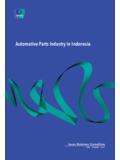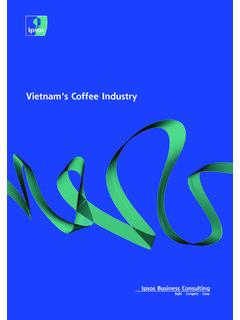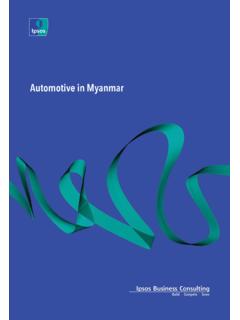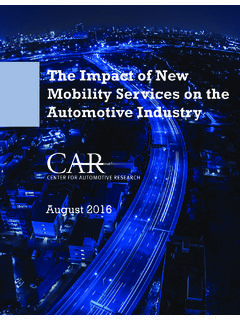Transcription of OPPORTUNITIES AND CHALLENGES IN INDONESIA’S …
1 1 OPPORTUNITIES AND CHALLENGES IN indonesia S automotive INDUSTRY February 2016 2 Executive Summary Over the next five years the passenger vehicle segment will remain very attractive, while growth of the commercial vehicle segment will be slower Passenger vehicle (PV) growth is estimated at CAGR to 2020 Motorcycle (MC) growth is estimated at CAGR to 2020 Truck growth is estimated at CAGR to 2020 Bus growth is estimated at CAGR to 2020 Greater Jakarta will remain the key region driving PV and CV growth, while demand from medium and smaller-sized cities is expected to increase over the next decade In the PV segment, the lo- cost green car segment (LCGC) is expected to experience the fastest growth at CAGR to 2020 In the truck segment, the gasoline light-duty truck segment (GLDT)
2 Is expected to experience the fastest growth at CAGR to 2020 In the bus segment, the medium-duty bus segment (MDB) is expected to experience the fastest growth at CAGR to 2020 3 Three Main Implications for New market Entrants 1 2 3 Competitive Landscape Localization Impact Japanese OEM brands dominate the market Long history in the market Comprehensive portfolio Extensive dealership networks High brand awareness Develop differentiated and focused value proposition to target specific consumer segments Include distribution and service implications when prioritizing cities and regions for market entry Carefully review and
3 Understand relevance of government policy to market entry strategy Geographical Landscape Government preference for OEMs to increase local production Local content targets for parts production Policies supporting high local content models Demand spread across vast country Top four cities account for only 26% of total PV population Logistic CHALLENGES to ensure distribution and service coverage 4 VEHICLE AND MOTORCYCLE market TRENDS VEHICLE market TRENDS IPSOS BUSINESS CONSULTING 5 Unit: USD billion** City Level GDP 2014* City Level Population 2014 Java, with half of the Indonesian population, will remain the economic and political center of indonesia , accounting for over half of the GDP output.
4 With a depreciation of over 10% in 2015, stabilizing the currency will be vital for the Government to ensure growth. Nominal GDP Development* Key Cities at a Glance ECONOMIC OVERVIEW Makassar Bandung Surabaya Medan Jakarta Palembang Unit: USD billion** Unit: Million people 913 889 896 1,307 201320142015e2020fCAGR CAGR *GDP is calculated using current price ** USD exchange rate: 1 USD = IDR With GDP forecasted to reach USD trillion in 2020, large urban centers will emerge driving a more balanced growth and providing new OPPORTUNITIES Source: BPS.
5 IMF 6 43 56 22 30 2015e2020fUnit: Population in Millions Urbanization Level Consuming Class Population* *Source: McKinsey, The archipelago economy: unleashing indonesia 's potential, Ipsos Analysis Note: Consuming class is defined as individuals with a net income of above USD3,600 per annum at 2005 purchasing power parity (PPP) Affluent consuming class Mass consuming class Wealthy class 67 88 <2 <2 53% 57% 47% 43% 2015e2020fUnit: Population in Millions Urban Rural CONSUMER DEVELOPMENT Continued urbanization and the addition of 21 million new consumers will drive overall consumption and the demand for passenger vehicles and motorcycles Total Comments Urbanization could reach 70% by 2030, which will require significant infrastructure development and other investment to support growth of the smaller cities that will integrate the new urban citizens.
6 With a share of roughly 30% of total population, smaller cities, defined as having a population between 150,000 and two million inhabitants, are expected to be able to grow at an estimated 6-9% annually. The growing working-age population will play a key role in driving new consumption. Ensuring the economic growth is more evenly distributed across the country will be a key challenge over the coming years. 7 For OEMs assessing market entry OPPORTUNITIES , the MPV and LCGC* segments are expected to remain the highest volume and growth segments through to 2020 2013201420152020fCAGR CAGR Unit: Million Units PV Population 2013-2020 122 101 79 85 34 22 18 16 51 172 165 244 140 118 135 185 533 467 340 492 2013201420152020fUnit.
7 Thousand Units CAGR CAGR CAGR 13-15 PV New Sales by Segment 2013-2020 PASSENGER VEHICLE market OVERVIEW CAGR 15-20 *LCGC Low Cost Green Car **Other car types include hatchbacks and city cars 880 880 737 1,022 MPV SUV LCGC Sedan Other** MPVs and SUVs are popular due to their larger seating capacity, which are viewed as more suitable for Indonesian families. Declining popularity of sedan cars is partly due to the higher luxury tax imposed at 30%, while MPV and LCGC models are only taxed at 10% and 0% respectively.
8 8 41% 21% 15% 8% 3% 3% 9% Total: 736,664 cars The key competitive advantages of Japanese OEMs are: -Localization: -Most Japanese brands have local plants, allowing for ~30% cheaper taxes than CBU units imported -Products and model specifications fit local needs; such as focusing on small engine cars to capitalize on favorable tax policies for fuel-efficient vehicles -Geographical coverage: A wide-spread distribution network allows for convenient servicing and spare parts availability -Government support: Trade agreements resulting in lower import duties for Japanese companies Recent new entrants have chosen different strategies to enter the market -Chinese brands have struggled with Japanese dominance.
9 Geely and Chery have an insignificant share of ~1%, despite having low priced cars -German brands (Mercedes, BMW, Audi) avoid direct competition by targeting premium customer segments -Hyundai s buy-back guarantee * offer has enabled them to minimize perception of the poor resale value of Korean cars Others* New PV Sales by Brand 2015 Comments PASSENGER VEHICLE BRAND SHARE To successfully compete against the dominance of Japanese brands, new entrants must focus on brand building and development of distribution and after-sales capabilities *Other includes Chery, Geely, Tata.
10 Hyundai and KIA 9 Number of PV Car Models 2010-2015 1 2 2 3 1 1 6 3 1 1 1 1 1 1 3 2 1 1 2 2 6 3 3 3 5 3 ToyotaHondaDaihatsuSuzukiNissanMitsubish iNumber of PV Models by Segment 2015 189 209 20102015As the PV market becomes more mature, providing consumers with a well rounded portfolio will be necessary for OEMs targeting the low- to mid-end segment 17 11 8 8 9 6 MPV SUV LCGC Sedan Other** Total PASSENGER VEHICLE MODELS Total increase in PV models is attributed to the introduction of LCGC and an increase in the number of SUV and sedan models, which have increased by ~30% and ~10% since 2010 respectively.









